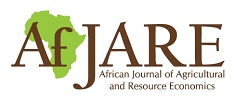Modelling the optimal cropping pattern to 2030 under different climate change scenarios: A study on Egypt
Abstract
Climate change and heat stress are expected to worsen the issue of water scarcity that is affecting the agricultural sector, among others through increased crop prices and costs, in addition to changes in yields. A crop-mix optimisation model was developed that maximises Egypt’s net revenue while lightening the impacts of climatic change throughout the study period – from 2013 to 2030. The optimal cropping pattern was obtained through iteration of the model on an annual basis using the projected values of the following variables: yield, arable land, costs, prices and consumptive water use. The model is restricted by sets of constraints concerning water and land availability. These variables were projected under different climate-change scenarios using various modelling techniques. The model improves the cropping pattern in Egypt by favouring crops that achieve high profitability while using a small amount of water for irrigation and crops that have a comparative advantage in the above-mentioned variables, while decreasing all crops that are nonprofitable, that use a large amount of water for irrigation, and that are heat intolerant. As a result, the total net revenue is expected to double at the end of the term. The system of models integrated in this study establishes a platform for decision makers to examine different strategies and policies.
